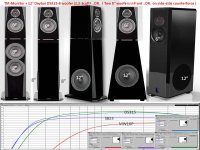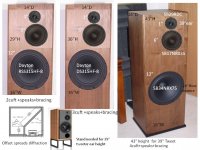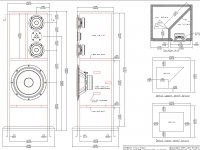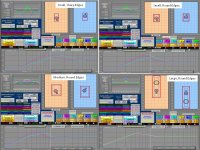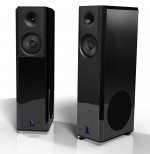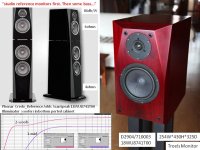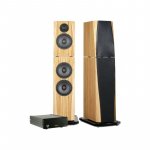I am saving up to do my first speaker build and am aiming to get the flattest and most accurate response for stereo music listening primarily. I will probably watch movies with these at some point but the main purpose is music. With that said I don't really need the really low frequencies down to 20 Hz. I would like the bass to be punchy and very responsive but not boomy. I would like to try and keep the enclosure relatively small and am looking to build about the same size as a JBL L112 24in h x 14.25 in w x 11 in d. With the parts I picked below I believe it is possible in a sealed box.
I have read there is a pretty steep drop off of the low end if you put the sub in a sealed enclosure but if the sub I have selected is rated down to 25 Hz and I'm mostly looking at listening material at 40 Hz and above is that a problem? Do you think the components below might work well together especially at the crossover points I picked?
I am pretty much going by the freq. response graphs provided by the manufacturers of these products as I'm pretty new at this but the speakers appear to be flat in a wide enough range that it should have the intended affect that I'm wanting. I appreciate any advice you could give and will hopefully be able to document the process of building them and letyou know how they turn out in the end.
1in Tweeter
https://www.parts-express.com/tang-band-25-302sh-1-neodymium-soft-dome-tweeter--264-804
5in Mid
https://www.parts-express.com/faita...ional-midbass-midrange-woofer-8-ohm--294-1141
12in Woofer
https://www.parts-express.com/dayton-audio-rss315hfa-8-12-reference-hf-subwoofer-8-ohm--295-445
Crossover 500/3500 Hz
https://www.parts-express.com/eminence-pxb3-3k5-3-way-speaker-crossover-board-500-3500-hz--290-652
I have read there is a pretty steep drop off of the low end if you put the sub in a sealed enclosure but if the sub I have selected is rated down to 25 Hz and I'm mostly looking at listening material at 40 Hz and above is that a problem? Do you think the components below might work well together especially at the crossover points I picked?
I am pretty much going by the freq. response graphs provided by the manufacturers of these products as I'm pretty new at this but the speakers appear to be flat in a wide enough range that it should have the intended affect that I'm wanting. I appreciate any advice you could give and will hopefully be able to document the process of building them and letyou know how they turn out in the end.
1in Tweeter
https://www.parts-express.com/tang-band-25-302sh-1-neodymium-soft-dome-tweeter--264-804
5in Mid
https://www.parts-express.com/faita...ional-midbass-midrange-woofer-8-ohm--294-1141
12in Woofer
https://www.parts-express.com/dayton-audio-rss315hfa-8-12-reference-hf-subwoofer-8-ohm--295-445
Crossover 500/3500 Hz
https://www.parts-express.com/eminence-pxb3-3k5-3-way-speaker-crossover-board-500-3500-hz--290-652
Hang on to your money until you find a proven 3-way design which meets your cost, size, performance, construction complexity, and style requirements. You want to study until you can explain: "I want to build a $cost$ speaker like the XXXXX" or the "YYYY" BECAUSE.....
1) The Eminence crossover you selected will not work with your drivers. It is designed for "pro audio" woofer + two horn drivers. You must design a crossover just for your specific drivers, baffle shape, listening room, etc...
2) The (Dayton Audio RSS315HFA-8 12" Reference HF Subwoofer 8 Ohm) is a low 85db sensitivity subwoofer with a heavy/slow 196g Mms. The T/S parameters work best in a ported 4cuft box tuned for 22Hz, or a sealed 2cuft box tuned to 40Hz. Parts Express has a great sale price, if you can find a proven design using this speaker.
.
3) The 87db sensitivity 5" Faital is good midrange, but not a great match for a 12" low efficiency subwoofer like the 196g Mms Dayton. Look for a higher efficiency woofer with under 100g Mms to match well with the Faital.
4) The Tang Band 25-302SH tweeter is a good match for the 5" Faital, but you must build a crossover designed just for Faital+Tang+cabinet_baffle. You need a different crossover for a wide baffle cabinet; than for a narrow baffle cabinet; then for center placement tweeter vs. off-center placement; than for beveled edges.....
THAT BEING SAID: If you already owned these speakers, someone could design a custom crossover and get a decent sounding low efficiency speaker.
One box or Two?
1) The Eminence crossover you selected will not work with your drivers. It is designed for "pro audio" woofer + two horn drivers. You must design a crossover just for your specific drivers, baffle shape, listening room, etc...
2) The (Dayton Audio RSS315HFA-8 12" Reference HF Subwoofer 8 Ohm) is a low 85db sensitivity subwoofer with a heavy/slow 196g Mms. The T/S parameters work best in a ported 4cuft box tuned for 22Hz, or a sealed 2cuft box tuned to 40Hz. Parts Express has a great sale price, if you can find a proven design using this speaker.
.
3) The 87db sensitivity 5" Faital is good midrange, but not a great match for a 12" low efficiency subwoofer like the 196g Mms Dayton. Look for a higher efficiency woofer with under 100g Mms to match well with the Faital.
4) The Tang Band 25-302SH tweeter is a good match for the 5" Faital, but you must build a crossover designed just for Faital+Tang+cabinet_baffle. You need a different crossover for a wide baffle cabinet; than for a narrow baffle cabinet; then for center placement tweeter vs. off-center placement; than for beveled edges.....
THAT BEING SAID: If you already owned these speakers, someone could design a custom crossover and get a decent sounding low efficiency speaker.
One box or Two?
Attachments
I still have a lot to learn then =S No I haven't bought the speakers yet for this same reason. I want to make sure that the combination I'm getting will working before I put down money for it.
I just recently found this post -> Intro to designing Crossovers without measurement on this same forum. Do you have any other resources that could cover some of these topics as well?
I just recently found this post -> Intro to designing Crossovers without measurement on this same forum. Do you have any other resources that could cover some of these topics as well?
Continuing to read and shop more I found a Dayton 12in driver with 100.7g mms and 90 db efficiency that still has a good flat response which surprised me for under $50. I'm going to continue reading up on crossovers to try and answer as many questions as I have about those before asking here.
Also I was hoping to to do a one box enclosure instead of two. The space these will more than likely end up is my basement which is medium to small sized space which currently is finished with drywall but bare concrete floors at the moment. Planning on putting laminate floors in the next few months though probably.
dayton-audio-dc300-8-12-classic-woofer
understanding-loudspeaker-data
Also I was hoping to to do a one box enclosure instead of two. The space these will more than likely end up is my basement which is medium to small sized space which currently is finished with drywall but bare concrete floors at the moment. Planning on putting laminate floors in the next few months though probably.
dayton-audio-dc300-8-12-classic-woofer
understanding-loudspeaker-data
I would suggest you visit Parts Express Techtalk forum and check out the stickies at the top of the main forum. There is one called "speaker building bible" that gives you tons of information.
Also google "undefinition Paul Carmody" which Paul's website and he has created some very popular kits in all price ranges. He also has a full write-up on how to simulate a XO using manufacture FR and impedance plots.
Take your time and don't get a hurry, there is a TON to learn. The good thing is both of these forums have very knowledgeable and helpful people to assist and teach you.
Also google "undefinition Paul Carmody" which Paul's website and he has created some very popular kits in all price ranges. He also has a full write-up on how to simulate a XO using manufacture FR and impedance plots.
Take your time and don't get a hurry, there is a TON to learn. The good thing is both of these forums have very knowledgeable and helpful people to assist and teach you.
I would suggest you visit Parts Express Techtalk forum and check out the stickies at the top of the main forum. There is one called "speaker building bible" that gives you tons of information.
Also google "undefinition Paul Carmody" which Paul's website and he has created some very popular kits in all price ranges. He also has a full write-up on how to simulate a XO using manufacture FR and impedance plots.
Take your time and don't get a hurry, there is a TON to learn. The good thing is both of these forums have very knowledgeable and helpful people to assist and teach you.
Thanks Bullittstang! Going to be going through the Speaker Building Bible soon. Can't wait to learn and build my first pair.
For selecting drivers especially the woofer, you need to use a box modeling program like Unibox or WinISD. Unibox uses Excel as do a couple of other essential programs to roll your own.
Also for driver selection, Zaph|Audio for driver measurements especially harmonic distortion and resonant behavior.
Or if you think learning to walk before you run might be prudent, Troels has several 3-way classic speakers that may fit your goals that he has already designed.
Also for driver selection, Zaph|Audio for driver measurements especially harmonic distortion and resonant behavior.
Or if you think learning to walk before you run might be prudent, Troels has several 3-way classic speakers that may fit your goals that he has already designed.
A Tale of Three sealed box 12" woofers.
--BOOM-BOOM BASS in 2cuft cabinet with 85db sensitivity. $135
Dayton RSS315HFA-8 will produce powerful F3=40Hz bass in sealed 2-cuft cabinet. Good motor with inductance-ring, but low efficiency from 195g Mms required for low F3 in a small volume. Favors 7" midrange. Great Basement speaker!
--BUDGET BASS in 3cuft cabinet with 89db sensitivity F3~44Hz . $75
Dayton DS315-8 will produce F3=44Hz bass in a sealed 3-cuft cabinet. Best performance/$$. Favors 6" midrange. Better build and specs than DC315-8.
--MUSICAL BASS in 4cuft cabinet with 89db sensitivity. $170
SB Acoustics SB34NRX75-6 will produce detailed+powerful F3=35Hz bass in a sealed 4-cuft cabinet. Great low inductance motor. Very musical with 89db sensitivity from 99g Mms. Big sealed floor stander = best sound. Can be used with high efficiency 5" midrange like Faital 5FE120, but might blend better with 6" midrange.
=================
A 12" front facing woofer typically has ~13.5" screw rim and requires ~16" wide cabinet.
Speaker Expert "Zilch" designed a 3-way MTM-W with a 12" woofer in a sealed 4cuft floor standing cabinet which received good reviews. I would never build an MTM but the basic cabinet construction can be adapted to a TMW three way with different heights.
Attached a few baffle diffraction sims which illustrate how your goal of "very flat reponse" requires well engineered cabinets.
Have you found any proven diy designs that meet your goals?
--BOOM-BOOM BASS in 2cuft cabinet with 85db sensitivity. $135
Dayton RSS315HFA-8 will produce powerful F3=40Hz bass in sealed 2-cuft cabinet. Good motor with inductance-ring, but low efficiency from 195g Mms required for low F3 in a small volume. Favors 7" midrange. Great Basement speaker!
--BUDGET BASS in 3cuft cabinet with 89db sensitivity F3~44Hz . $75
Dayton DS315-8 will produce F3=44Hz bass in a sealed 3-cuft cabinet. Best performance/$$. Favors 6" midrange. Better build and specs than DC315-8.
--MUSICAL BASS in 4cuft cabinet with 89db sensitivity. $170
SB Acoustics SB34NRX75-6 will produce detailed+powerful F3=35Hz bass in a sealed 4-cuft cabinet. Great low inductance motor. Very musical with 89db sensitivity from 99g Mms. Big sealed floor stander = best sound. Can be used with high efficiency 5" midrange like Faital 5FE120, but might blend better with 6" midrange.
=================
A 12" front facing woofer typically has ~13.5" screw rim and requires ~16" wide cabinet.
Speaker Expert "Zilch" designed a 3-way MTM-W with a 12" woofer in a sealed 4cuft floor standing cabinet which received good reviews. I would never build an MTM but the basic cabinet construction can be adapted to a TMW three way with different heights.
Attached a few baffle diffraction sims which illustrate how your goal of "very flat reponse" requires well engineered cabinets.
Have you found any proven diy designs that meet your goals?
Attachments
LineSource, can you please tell me where you image came from?
My Avatar is from the front cover of my Full Range Apogee Speaker users manual.
The other speaker images are photoshop of the Lansche 4x2 Black which uses a ionic plasma tweeter, and the Phonar-Credo reference speakers which use the ScanSpeak 18WU/8741T00 driver paired with either 7100 or 6600 tweeters. Both the midbass and the two woofers in the Phonar are ScanSpeak 18WU/8741T00 drivers. Troels Gravesen's diy site describes his "Illuminator Monitor" which uses the same drivers, and might be the inspiration of the Phonar design.
Simulation of these beveled-edge cabinets show good diffraction control with simple cuts.
Attachments
I still have a lot to learn then =S No I haven't bought the speakers yet for this same reason. I want to make sure that the combination I'm getting will working before I put down money for it.
I just recently found this post -> Intro to designing Crossovers without measurement on this same forum. Do you have any other resources that could cover some of these topics as well?
I would advice you to forget all about designing "your" speaker from scratch. It takes years and maybe thousands of hours to master the "art" of designing a speaker. Theoretical crossovers without measurements will NEVER give you the best result. This is not my opinion, but a simple fact. Also, forget about combining crossovers from different speakers - It does nok work that way.
Even if you buy a proven kit, it may take you 100-200 hours before you are done with cabinets ie ready to listening to music. If you start from scratch, it takes you the same time, but you are by no means sure that the result will be any better than a cheap second hand speaker. This is also a fact.
Also - I havent even mentioned that behind a proven kit, it takes many iterations of the cabinet and many iterations of the crossover, to end with a good result. In this regard, a proven kit is really not that expensive, because you typically dont have to pay for the many hours put into i.
So basically you have two options to choose from:
Will you spend your time the best possible way, buy building your speaker on a proven design OR will you rather gamle with your time?
Even in a proven kit, there is quite some room to make your personal touch on it. As long as you stick with the EXACT dimensions of the frontbaffel and the drivers plus the same internal volume, you are relatively safe.
This is not meant to sound harsh, but a friendly advice 🙂
Download and learn to use XSim.
Go for well behaved drivers with flat responses and understand baffle step compensation before you order your drivers
Once you are ready, start a thread build on PE tech talk. They will chime in with advice, encouragement and even crossover sims
Go for well behaved drivers with flat responses and understand baffle step compensation before you order your drivers
Once you are ready, start a thread build on PE tech talk. They will chime in with advice, encouragement and even crossover sims
Last edited:
Here is one diy example of putting the 12" SB34NRX75-6 woofer on the side panel to maintain a narrow front baffle. This design uses a 5" midrange with an efficiency which integrates well with the 12" woofer after side baffle step compensation.
https://areteaudio.wordpress.com/tag/passive-crossover/
https://areteaudio.files.wordpress.com/2016/04/ajj-994-transducer-report.pdf
AJJ 994’s 3-Way Floorstanding Passive System
Drivers:
Dome Tweeter: SB Acoustics SB29RDC-C000-4
5″ Midrange: SB Acoustics SB15NRXC30-4
12″ Woofer: SB Acoustics SB34NRX75-6
https://areteaudio.wordpress.com/tag/passive-crossover/
https://areteaudio.files.wordpress.com/2016/04/ajj-994-transducer-report.pdf
AJJ 994’s 3-Way Floorstanding Passive System
Drivers:
Dome Tweeter: SB Acoustics SB29RDC-C000-4
5″ Midrange: SB Acoustics SB15NRXC30-4
12″ Woofer: SB Acoustics SB34NRX75-6
- Status
- Not open for further replies.
- Home
- Loudspeakers
- Multi-Way
- 3-way build Advice (first build)
